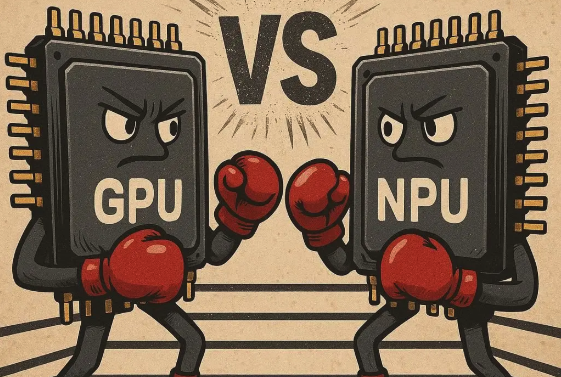The AI Hardware Wars: Silicons | 매거진에 참여하세요
The AI Hardware Wars: Silicons
#hardware #NPU #TPU #GPU #limit #Slilcon #computing
The AI Hardware Wars: GPUs, NPUs, and the New Silicon Order: From the Age of Software to the Age of Hardware
For the past decade, breakthroughs in artificial intelligence have centered on software, new model architectures and algorithmic innovations.
Names like GPT, LLaMA, and Stable Diffusion became synonymous with AI’s rapid progress.
But as we enter 2025, the new battleground is not software, but hardware.
Models have already surpassed what most of us thought possible.
The real question now is: How fast, how efficiently, and how cheaply can we run them?
Enter the era of GPUs, NPUs, and custom AI silicon , chips that are no longer just semiconductors, but the core building blocks of what some call the “Silicon Order.”
GPU: Nvidia’s Reign at the Top
The golden age of AI was powered by the GPU.
Originally built for rendering game graphics, GPUs turned out to be the perfect engine for deep learning with their thousands of cores capable of parallel vector operations.
The CUDA Advantage
Nvidia didn’t stop at selling GPUs. With CUDA, it built a developer ecosystem that made “AI without GPUs” nearly unthinkable. This shifted Nvidia from being just a hardware vendor into a true platform company.
A100, H100, and Blackwell
H100 became legendary as the backbone behind training GPT-4, Claude, and Gemini.
The newly announced Blackwell architecture pushes new boundaries in memory bandwidth and power efficiency.
But there’s a catch: price. With H100s trading above $30,000 per unit, the GPU is now called the “new oil” of the AI age.
NPU: From Smartphones to the Cloud
If GPUs are about general-purpose compute power, NPUs (Neural Processing Units) focus on optimizing specific AI workloads
with maximum efficiency and lower power.
On-Device AI
Chips like Apple’s A17 Pro and Qualcomm’s Snapdragon X Elite already embed NPUs, enabling on-device AI in smartphones and laptops. Features like photo enhancement, speech recognition, and live translation now work seamlessly , even without an internet connection.
In the Cloud
Cloud hyperscalers are also moving toward custom silicon:
Google’s TPU,
Amazon’s Trainium/Inferentia.
These are essentially “large NPUs,” purpose-built for massive training and inference, helping cloud providers reduce dependence on Nvidia.

GPU vs. NPU vs. TPU vs. Tesla’s Dojo Silicon
Chip | Use Case | Strengths | Weaknesses | Makers | Best Fit |
|---|---|---|---|---|---|
GPU | General compute, graphics, AI | Versatility, CUDA ecosystem, high performance | Expensive, power-hungry, comms bottlenecks | Nvidia, AMD | Servers, HPC |
NPU | AI-optimized compute (edge/mobile) | Low power, efficient AI ops, edge-ready | Limited general compute | Apple, Huawei, Samsung, MediaTek | Smartphones, IoT, robotics |
TPU | Large-scale training & inference | High efficiency at scale, cloud-optimized | Low general-purpose use, cloud-only | Data centers | |
AI6 (Tesla) | Autonomous driving, robotics | Integrated NPU efficiency, Dojo integration | Production constraints, limited scope | Tesla (Samsung Foundry) | Cars, robotics, Tesla Dojo |
The Limits of GPU Scaling

GPUs have driven AI to its current heights , but they’re running into physical, economic, and efficiency bottlenecks:
Distributed training overhead:
More GPUs = higher communication costs, diminishing returns.
Moore’s Law slowdown:
By 2027–2035, transistor miniaturization hits physical limits.
Model size plateau:
Scaling alone no longer guarantees performance gains.
Rising costs:
Training and inference for massive models is prohibitively expensive, creating demand for smaller, efficient models.
This is why NPU/TPU-style custom silicon is rising: GPUs remain the engine of general AI compute,
but specialized chips are emerging as the efficient, task-optimized engines.
Who Wins the Hardware War?
The next phase of the AI hardware race won’t be won by raw chip performance alone.
It will depend on ecosystems, supply chains, and cost efficiency.
- Nvidia:
Still dominant with GPUs + CUDA, but facing price and power limitations.
- Google, Amazon, Microsoft:
Strengthening their cloud platforms with in-house TPUs/NPUs.
- Apple, Qualcomm:
Driving on-device AI with NPUs, leading the edge AI revolution.
The AI hardware future is moving toward a hybrid ecosystem , a mix of general-purpose GPUs and specialized silicon rather than GPU monopoly.
Final Word
The AI race is no longer about who can build the biggest model,
but who can build the fastest, cheapest, and most efficient silicon to run it.
The GPU era isn’t over, but it’s no longer alone.
NPUs, TPUs, and custom AI silicon are reshaping the battlefield, creating a new Silicon Order where efficiency is the ultimate competitive edge.






